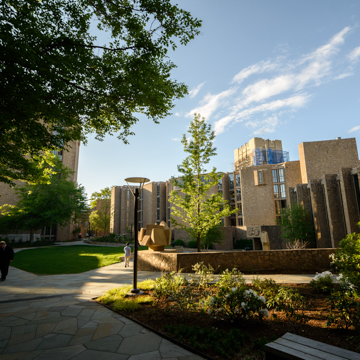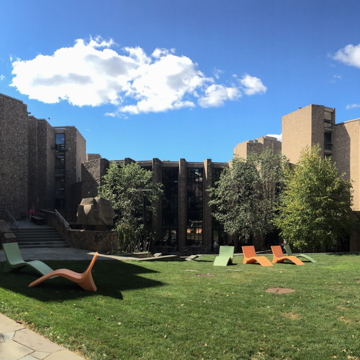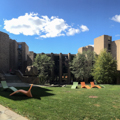Ezra Stiles and Morse Colleges, part of Yale University’s residential college system, are located on the western edge of the New Haven campus. Built by Yale alumnus Eero Saarinen, these buildings are among his final works. For their design, the AIA posthumously awarded Saarinen a gold medal in 1962.
Yale University purchased the lot between Broadway and Tower Parkway in 1955 with the intention to add residences for its growing student population. Three years later, philanthropist and Yale alumnus Paul Mellon donated the funds for the two new colleges, which would be named for Ezra Stiles, who graduated from Yale in 1746 and served as the university’s president from 1778 to 1795, and Yale alumnus and inventor of the telegraph, Samuel F.B. Morse.
Saarinen had previously designed Yale’s David S. Ingalls Hockey Rink (1956–1959), a modernist, reinforced concrete arena that is commonly referred to as “The Whale” due to its shape. His concept for Ezra Stiles and Morse Colleges differed significantly from the rink. The irregular building site for the residential colleges was flanked by two imposing Neo-Gothic towers from 1930: James Gamble Rogers’s Hall of Graduate Studies and John Russell Pope’s Payne Whitney Gymnasium. Saarinen wanted to create a building complex that would form a harmonizing connection between the Hall of Graduate Studies and the Gymnasium.
In order to create a modern structure that would reflect a Neo-Gothic spirit, Saarinen took inspiration from the medieval Italian hill town of San Gimignano and from old Pennsylvania houses whose facades had worn off, exposing the stonework. Traditional masonry would have been too expensive for the university’s budget, so Saarinen developed a technology that he called “masonry walls made without masons.” Rubble was filled into formwork, then concrete injected and an expanding agent added, in order to prevent the grout from shrinking during the drying process. Lastly, the surface was washed under high pressure to expose the stones and create the desired effect.
In interviews with students, Saarinen concluded that the rooms should reflect individuality and diversity, and should be “as random as those in an old inn rather than as standardized as those in a modern motel.” Therefore, Saarinen opted for a polygonal design, where the individual rooms would be clustered around shared spaces such as bathrooms and stairwells. Most of the rooms are single occupancy and provide approximately 172 square feet per student. They feature a walk-in closet, built-in desk, and floor-to-ceiling windows. The main structures are flat-roofed and four stories high, and are flanked by a ten-story and a fourteen-story tower.
Stiles and Morse were built to accommodate 250 students each. While both colleges have their own private courtyard, a large open green space sets back the crescent-shaped building complex from Tower Parkway and Payne Whitney Gymnasium. The two residential facilities are connected via a multi-level pedestrian passageway, which houses the shared kitchen underneath. Each college has its own master’s house, accommodations for deans and college fellows, a double-height dining hall, seminar rooms, library, rooms for billiards and table tennis, and the so-called smaller “butteries” or snack bars in lieu of the large common rooms found in the older residential colleges.
Due to the building complex’s irregular shapes—there are no right angles formed by the exterior walls—sunlight offers a great play of light and shadow, adding richness to the facade. Walter McQuade described this effect as “powerful without becoming chaotic.” Other contemporaneous reviewers, however, dismissed Stiles and Morse for their picturesqueness. While Vincent Scully remained critical of Saarinen’s approach and Paul Rudolph called Stiles and Morse “a stage setting for Ivanhoe,” the harshest reproach came from British critic Reyner Banham, who proclaimed that he was “disgusted” by Saarinen’s latest additions to Yale’s campus.
Saarinen achieved a counterbalancing verticality through each of the college’s towers and by stacking the windows in one line atop one another. The towers seamlessly blend into the campus landscape. A walk through the complex reveals views of Payne Whitney Gymnasium, the Hall of Graduate Studies, and sculptures and reliefs by Costantino Nivola. G.E. Kidder Smith praised the interconnection between Stiles, Morse, and its two neighbors as a “well-scaled conspiracy of four buildings,” noting that “the passage connecting them numbers among the country’s most subtle developments of open-air linear footage.”
In 2011, Saarinen’s Stiles and Morse colleges were renovated and expanded by the Philadelphia firm Kieran Timberlake Architects. While the original exterior was preserved, 25,000 square feet were added underground for a theater and other common spaces. Also, Saarinen’s original conception of all “single” residencies was remade to fit the more typical Yale pattern of “suites.”
References
Banham, Reyner. “Morse and Stiles.” New Statesman (July 13, 1962). Reprinted in Architectural Forum 117 (December 1962), 110–111.
Brown, Elizabeth Mills. New Haven: A Guide to Architecture and Urban Design. New Haven: Yale University Press, 1976.
Dardi, Domitilla. Eero Saarinen. Milan: 24 Ore Cultura Srl, 2011.
Kidder Smith, G.E. Sourcebook of American Architecture. 500 Notable Buildings from the 10th Century to the Present. New York: Princeton Architectural Press, 1996.
McQuade, Walter. “The New Yale Colleges.” Architectural Forum 117 (December 1962), 104–111.
Merkel, Jayne. Eero Saarinen. New York: Phaidon Press, 2005.
Pelkonen, Eeva-Liisa, and Donald Albrecht, eds. Eero Saarinen. Shaping the Future. New Haven: Yale University Press, 2006.
“Polygonal Architecture.” Architectural Record 127, no. 2 (February 1960), 159–164.
Román, Antonio. Eero Saarinen. An Architecture of Multiplicity. New York: Princeton Architectural Press, 2003.
Saarinen, Eero. “Eero Saarinen.” Perspecta 7 (1961), 29–42.
“Saarinen Designs Two New Colleges for Yale.” Progressive Architecture 41, no. 1 (January 1960), 45–47.
“Saarinen Colleges in Situ at Yale.” Progressive Architecture 43 (November 1962), 57-60.
Scully, Vincent. American Architecture and Urbanism. New York: Frederick A. Preager, Inc., 1969.
Scully, Vincent. Modern Architecture and Other Essays. Selected and with Introductions by Neil Levine. Princeton, NJ: Princeton University Press, 2003.
Spade, Rupert. Eero Saarinen. With 70 photographs by Yukio Futagawa. New York: Simon and Schuster, 1971.
Stephens, Suzanne. “Morse and Ezra Stiles Colleges.” Architectural Record 199, no. 11 (November 2011), 97–101.
Temko, Allan. Eero Saarinen. New York: George Braziller, 1962.




